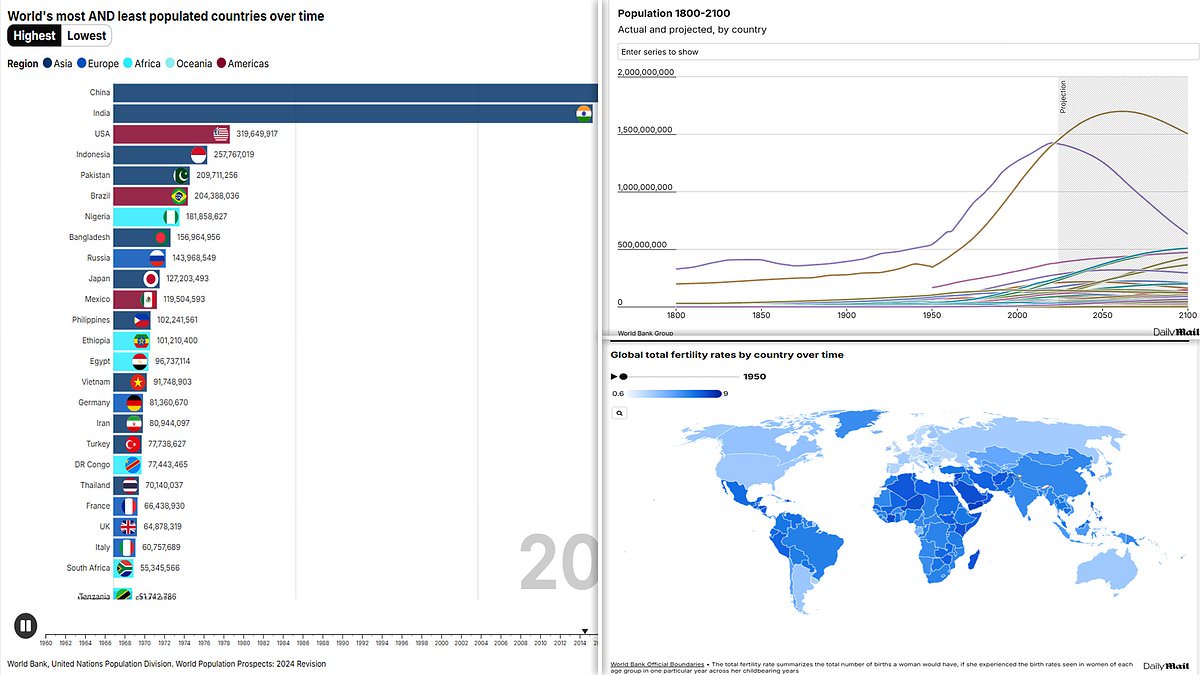
Published: | Updated:
Nearly 70 per cent of the world’s countries have seen their populations double since 1960, Daily Mail can reveal.
Mesmerising charts show how the global population has rocketed to exceed 8billion, despite global birth rates plummeting to all-time lows.
The United Arab Emirates and Qatar saw the largest leaps during the period, of over around 8,000 per cent, to 10.8m and 2.8m, respectively.
Eight countries saw their population decrease, with Bulgaria recording the biggest fall (-18 per cent).
India – home to 1.45billion people – officially overtook China to top spot in 2023, with its population having tripled in size since the 60s.
Over a third of the world now live in one of the two nations, World Bank figures show.
The US ranks a distant third at around 340million people.
For context, that’s approximately one billion fewer than 2nd-placed China, which is battling a population slump that has fuelled concerns of an impending ‘disaster’ for the economic superpower.
Between 1979-2015, the Chinese Communist Party maintained its controversial one-child policy in a bid to curb its post-war baby boom.
But a decade later, the country’s birth rate has plunged and the government is even offering parents a £375 per child annual bursary to reverse the decline.
India’s staggering population could even be an undercount because it hasn’t carried out a census for 14 years.
Prime Minister Narendra Modi announced earlier this month that India would undergo a full population count over the next two years.
The Pacific island of Tuvalu, meanwhile, has the smallest population in the world – at below 10,000.
In terms of the global league table, the UK’s population of 69million ranks 21st. It has increased by 32.1 per cent since 1960, when it ranked 9th.
The total world population has shot up 168.3 per cent in the same timeframe.
Despite the enormous population growth across the majority of the planet over the last 60 years, demographers warn the world is in the throes of a massive population crisis.
More than half of nations globally have a fertility rate below 2.1 – the recommended amount to sustain current populations.
Women in England and Wales, on average, now only have 1.44 children. This is the lowest level since records began in the 30s.
Yet, in parts of the country, this is as low as 0.1 – the equivalent of one child for every ten women of childbearing age, the Daily Mail revealed last month .
Without replenishment of an ageing population, scientists claim public services and economic growth are at risk. Ever-declining birth rates will also heap extra pressure on the NHS and social care.
Commentators warned that policymakers need to ‘wake up to the fact that falling fertility rates are one of the greatest threats’ to the West and that the country could become increasingly reliant on migration.
Looking ahead to 2100, nearly half of the world’s countries’ populations are expected to shrink, forecasts suggest.
Ukraine, Jamaica and Albania are among 14 nations set to halve in size. Hong Kong is expected to slide the most, at 72.4 per cent.
China will, according to estimates by the World Bank Group, dip below 1billion in 2071 and end the century at around 633m.
India’s population is expected to peak in the late 2060s.
As of 2024, more than 60 countries including China, Germany, and Japan have already hit their peak populations, according to the figures.
On the contrary, African and Middle Eastern nations are set to undergo a boom.
Atop the list is Angola, a nation of 37m. By 2100, it is expected to grow to over 150m people – a leap of nearly 300 per cent.
Close behind are the Democratic Republic of Congo (294.2 per cent) and Tanzania (283.4 per cent)
The UK’s population is expected to creep up by 7.3 per cent to just north of 74m.
The US, meanwhile, is projected to see a 23.9 per cent leap to nearly 430m.
Biggest % growth
1. UAE – 10,876,981 (81881.9 per cent)
2. Qatar – 2,857,822 (7,836 per cent)
3. Kuwait – 4,973,861 (1,499 per cent)
4. Sint Maarten – 43,350 (1,496 per cent)
5. Saudi Arabia – 35,300,280 (1349.7 per cent)
6. Djibouti – 1,168,722 (1,258 per cent)
7. Jordan – 11,552,876 (1,253 per cent)
8. Oman – 5,281,538 (895.6 per cent)
9. Bahrain – 1,588,670 (860 per cent)
10. Cayman Islands – 74,457 (783.5 per cent)
Biggest % fall
1. Bulgaria – 6,444,366 (-18.1 per cent)
2. Saint Kitts and Nevis – 46,843 (-16.1 per cent)
3. Latvia – 1,862,441 (-12.2 per cent)
4. Ukraine – 37,860,221 (-11.6 per cent)
5. Croatia – 3,866,300 (-6.6 per cent)
6. Hungary – 9,562,314 (-4.2 per cent)
7. Bosnia and Herzegovina – 3,164,253 (3.6 per cent)
8. Serbia – 6,587,202 (-0.8 per cent)
9. Georgia – 3673850 (0.8 per cent)
10. Romania – 19,069,340 (3.6 per cent)







